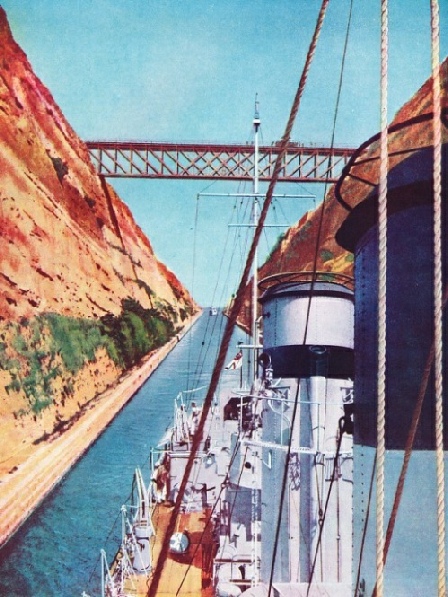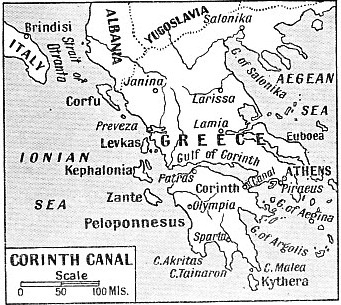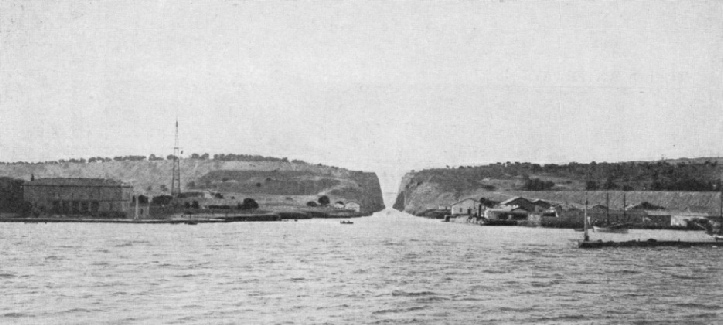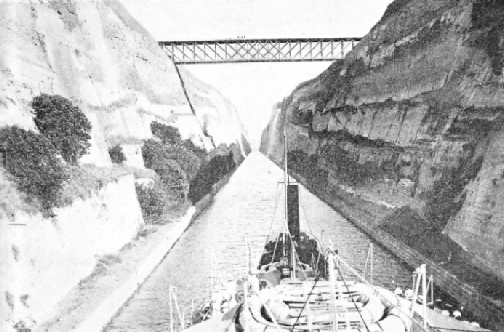

© Shipping Wonders of the World 2012-

The Corinth Canal
From the days of ancient Greece and Rome the question of a canal across the Isthmus of Corinth had been seriously considered. A canal was begun in AD 67, but it was not until 1893 that the project was realized and a new link in European maritime communications was made

BEGUN IN AD 67 BY THE ROMAN EMPEROR NERO but not completed until 1893, the Corinth Canal considerably shortened communications in the Mediterranean and converted the Gulf of Corinth into a thoroughfare. The length of the canal is 6,939 yards, or just under four miles. Its relatively narrow width (25 yards) makes it impracticable for vessels to pass one another. The ship illustrated is HMS Duncan, leading the First Destroyer Flotilla through the canal. The Duncan, launched in 1932, has a displacement of 1,400 tons, a length between perpendiculars of 317 ft 9 in, a beam of 33 feet, and a draught of 8 ft 8 in. She has just passed under the bridge that carries the railway between Athens and the Peloponnesos..
TWO long peninsulas extend southward from the continent of Europe into the Mediterranean, dividing that sea, on its northern side, into three unequal sections. The more westerly peninsula is Italy, the more easterly the Balkan Peninsula, ending in Greece.
A glance at the map of Europe will show that the northern part of Greece is almost divided from its southern extremity -
The Isthmus of Corinth is a tract of limestone rock less than four miles across at its narrowest and ten miles across at its widest. Its length is about ten miles and its orientation northeast to south-
On its northern, or rather northwestern side, in the Bay of Corinth -
The central part of the isthmus is a tableland, about 260 feet above the sea at its lowest point. On the southern side it shelves to the sea in steep terraces. The surface of the isthmus is waterless and mainly barren. The only vegetation consists of dwarf pines, shrubs and thistles, supplemented in spring by some apologetic patches of grass which disappear in the hot summer sun. Where soil exists it is cultivated with difficulty and yields scanty and reluctant crops of wheat and barley.
On the isthmus were anciently held the Isthmian Games, one of the four major festivals of Greece. The other famous festivals were the Olympic Games at Olympia, the Nemean Games at Nemea and the Pythian Games at Delphi. Olympia lies on the River Alpheus, on the western side of the Peloponnesus. Nemea is on the eastern side of the peninsula. Delphi is in northern Greece, and was regarded by the ancient Greeks as the centre of the world.
The idea of cutting a canal through the low-
The sailors of ancient Greece -
To the Greek sailor, therefore, the slender Isthmus of Corinth was a tantalizing barrier. As there was no canal, vessels wishing to pass by sea from the Gulf of Corinth to the Aegean or vice versa had almost to circumnavigate the Peloponnesus and run the gauntlet of its three capes.
But there was an alternative; that was to drag the ships across the four miles of the isthmus. The ships of antiquity were not too big to make such a measure impracticable. The labour of dragging these vessels across the isthmus was far preferable to the dangerous sea-
Thus there came into existence the Diolkos, or portage, across the Isthmus of Corinth. Those who are familiar with pleasure-
A similar idea, on a gigantic scale, was the basis of the ambitious but abortive proposal, before the Panama Canal was cut, to build a “ship railway” across the Isthmus of Panama. This “ship railway” was to have carried ocean-
The Isthmian Diolkos began at Schoenus, near the modern Kalamaki, in the Gulf of Aegina, and probably ended, in the Bay of Corinth, at a point near the northwestern end of the present canal. The Diolkos -

MEDITERRANEAN COMMUNICATIONS were considerably simplified by the opening of the Corinth Canal in November 1893. Ships of moderate dimensions from Brindisi and other Adriatic ports bound for the Piraeus and the Aegean no longer had to round the three notorious capes south of the Peloponnesus, Capes Akritas Tainaron and Malea.
It was used by men-
From portage to canal was an obvious step. One of the earliest rulers to contemplate the cutting of a canal was Periander, Tyrant -
The Corinthian tyrant anticipated by over a hundred years the resourcefulness of Xerxes (see pages 913-
Periander was presumably one of the most enlightened rulers of antiquity, for he was counted among the Seven Sages. His plan, however, for all his sagacity, did not proceed beyond the drawing-
The idea of a canal across the Isthmus of Corinth occurred also over three centuries later to the famous soldier Demetrius Poliorcetes (“the Besieger”), sometime King of Macedon. Demetrius, who lived from 337 to 282 BC, was a son of Antigonus, one of Alexander the Great’s generals. But the real credit for beginning operations on the canal is due to the Roman Emperor Nero, who reigned from AD 54 to 68.
Nero is usually regarded as the monster who used incandescent criminals to light his garden walks at night and as the decadent who fiddled while Rome burned. But his work at Corinth, though unfortunately uncompleted, bade fair to be of great public utility.
Begun by a Roman Emperor
The emperor inaugurated the work on the canal with great pomp in the year 67, one year before his death. At that time the whole of Greece formed part of the Roman Empire. Nero cut the first sod with a gold spade. Loss than half a mile, however, had been accomplished when the work had to be suspended because of an insurrection in Gaul.
The line of the canal begun by Nero was so well planned that it was adopted by the builders of the modern canal. In consequence the traces of the original works have been obliterated. To provide labour for this great undertaking, the general Vespasian -
Work was begun at several points. The various trenches had a depth of from 10 to 100 feet and a width of from 40 to 55 feet. Over 650,000 cubic yards are said to have been excavated in the three or four months that the operations lasted.
In 1829, towards the end of the War of Greek Independence, plans were made for the cutting of a canal, but the country had to wait over fifty years before anything more was done.
In 1881 the isthmus was surveyed, and on May 4, 1882, King George I of Greece, brother of Queen Alexandra, following the example of the Roman Emperor eighteen centuries before, made the first cut. The canal was opened for the passage of ships in November 1893. The work was begun by a French company and completed by a Greek company.
The length of the canal is 6,937 yards, or just under four miles; its width at the bottom is 25 yards and the depth of the water is 26 feet. The canal, which runs in a straight line across the isthmus, has no locks. It is protected, at its north-

STRAIGHT THROUGH THE ISTHMUS OF CORINTH, the canal cutting extends for nearly four miles, with no locks and no curves. The Corinth Canal is therefore more striking than many larger canals because it is possible to see from the Gulf of Aegina to the Gulf of Corinth through a cutting made by man The canal is used by many Mediterranean passenger vessels, warships and smaller craft for it shortens the distance from the Adriatic to the Piraeus, the port of Athens, by 185 nautical miles.
The absence of locks has necessitated extensive excavation. Towards the middle of the canal the cutting has a maximum depth of 260 feet. The slope of the sides is 10 in 1. Thus passengers in a ship passing through the canal have no view of the surrounding country. The Piraeus-
The strength of the current in the canal is from 1 to 3 knots. Great care is necessary to prevent the ships from bumping against the sides. The maximum permissible speed in the canal is 6 knots. Ships are sometimes assisted by tugs through the canal.
The Corinth Canal has shortened the distance between the Adriatic and the Piraeus by 185 nautical miles. Ships coming from Marseilles, Genoa or Naples save ninety-
Among the steamship and motorship lines using the Corinth Canal to-
The Adriatic-
Open to Warships
The Italian Adriatica line has a service between Venice and Izmir (Smyrna) which uses the canal, and another between Venice and the Piraeus serving Dalmatian ports.
Of the Greek lines using the Corinth Canal, theHellenicCoastLines have a service between Brindisi, Corfu and Crete.
The Greek National Steam Navigation Co. has a service operated by the steamer Andros (2,068 tons gross) between Marseilles, ithe Piraeus and Beirut through the Corinth Canal.
Another line using the Corinth Canal is the Yugoslav Jadranska Steamship Company, with its service between Susak or Trieste and the Piraeus. The steamers normally operating this service are the Beograd (864 tons gross) and the Srbin (982 tons gross). They call at various ports on the Dalmatian coast, and then at Santi Quaranta and Corfu. Calls are made also at Levkas, Patras and Vostiza (Aegion).
The largest vessels using the Corinth Canal, whether they are Italian, Greek or Yugoslav, have, as a rule, a gross tonnage not greatly exceeding 3,000. The Adriatica Line has two motorships of about 3,300 tons gross -
In addition to merchant ships, moderate-

CUT THROUGH SOLID ROCK to a depth of 260 feet at its deepest point, the Corinth Canal is crossed by only one bridge. This bridge carries the railway between Athens and Corinth. The bridge is 101 yards long and 144 feet above the water. This photograph was taken from HMS Curacoa, a cruiser of 4,290 tons displacement She is being assisted by a tug because of the difficulty of steering a vessel of this size in such confined waters. The canal is 25 yards wide at the bottom and has a depth of 26 feet.
You can read more on “The Nile”, “The Panama Canal” and “The Suez Canal” on this website.